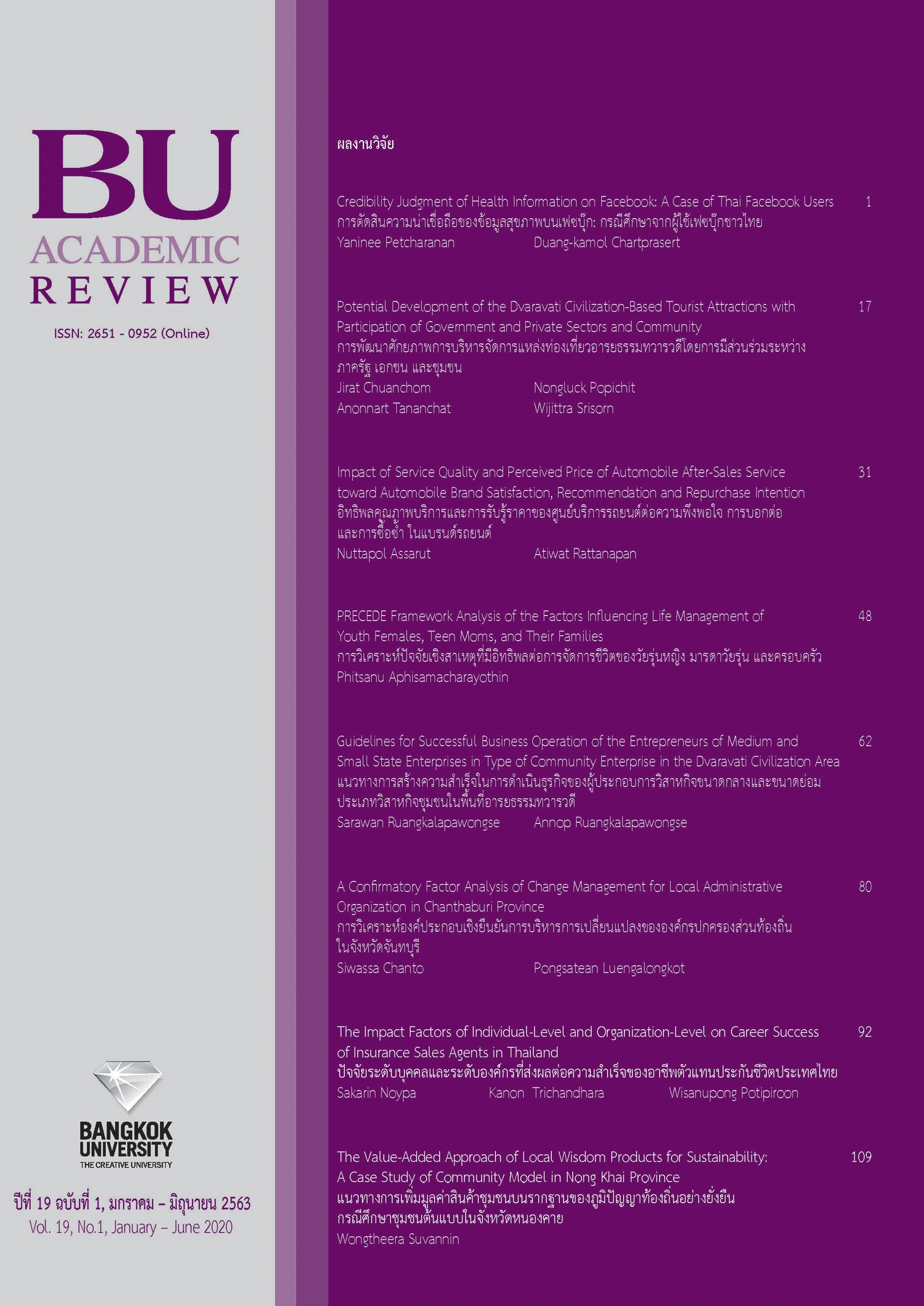การเพิ่มประสิทธิภาพการให้บริการรถโดยสารด้วยแบบจำลองสถานการณ์
Main Article Content
บทคัดย่อ
งานวิจัยนี้มีวัตถุประสงค์เพื่อสำรวจและวิเคราะห์สภาพการดำเนินงานในปัจจุบันของรถโดยสารภายในของจุฬาลงกรณ์มหาวิทยาลัย (รถ ปอ.พ) สายที่ 1 เส้นทางศาลาพระเกี้ยวถึงโรงภาพยนตร์ลิโด้ และตรวจสอบแนวทางเพื่อเพิ่มประสิทธิภาพการให้บริการในช่วงชั่วโมงเร่งด่วน ระหว่าง 15:30 ถึง 17:00 น. โดยใช้เกณฑ์ชี้วัดความมีประสิทธิภาพของระบบการให้บริการ 2 เกณฑ์ ได้แก่ การวัดความจุผู้โดยสารบนรถที่ไม่เกิน 1.72 และเวลารอคอยโดยเฉลี่ยของผู้โดยสารที่สถานีศาลาพระเกี้ยวและสถานีโรงภาพยนตร์ลิโด้ ที่ไม่เกิน 10 นาที ผู้วิจัยสำรวจสภาพการดำเนินงานในปัจจุบัน พบว่า มีปัญหาผู้โดยสารแออัดบนรถ จำนวนมากกว่า 36 คน และมีเวลารอคอยเฉลี่ยที่สถานีมากกว่า 10 นาที ซึ่งมากกว่าเวลาที่ผู้โดยสารส่วนใหญ่ยอมรับได้ และมากกว่าเวลาที่ระบบประกันตามตารางการเดินรถ ทำให้ผู้วิจัยเสนอวิธีปรับปรุงประสิทธิภาพการบริหารจัดการระบบรถ ปอ.พ. จำนวน 4 แนวคิด ได้แก่ (1) การลดจำนวนที่นั่งโดยสารภายในรถ (2) การนำรถสำรองมาเสริม (3) การลดจำนวนจุดจอดรถ และ (4) การปรับเปลี่ยนเส้นทางในการวิ่งโดยเลี่ยงเส้นทางที่สภาพการจราจรติดขัด โดยเริ่มต้นสร้างแบบจำลองภายใต้เกณฑ์ความจุผู้โดยสารบนรถ ตามเกณฑ์ที่กำหนด 1.72 หรือ 36 คน แบบจำลองสถานการณ์ถูกกำหนดไว้ที่อัตราสูงสุดของความจุบัสเป็น 36 ผู้โดยสารหรือ 1.72 ตัวประกอบภาระ ผลการศึกษาพบว่า มีเพียง 3 จาก 4 แนวคิด ที่สามารถลดระยะเวลารอคอยเฉลี่ยได้ตามเกณฑ์เมื่อเทียบกับระบบปัจจุบันอย่างมีนัยสำคัญ โดยเรียงลำดับร้อยละเวลารอคอยที่ลดลงเมื่อเทียบกับระบบปัจจุบันจากมากที่สุดไปน้อยที่สุด ดังนี้ (1) แนวคิดปรับเปลี่ยนเส้นทางในการวิ่งเลี่ยงเส้นทางที่สภาพการจราจรติดขัด ลดระยะเวลารอคอยเฉลี่ยลงร้อยละ 53 ในสถานีศาลาพระเกี้ยว และร้อยละ 40 ในสถานีโรงภาพยนตร์ลิโด้ (2) แนวคิดนำรถสำรองมาใช้ ลดระยะเวลารอคอยเฉลี่ยลงร้อยละ 34 ในสถานีศาลาพระเกี้ยว และร้อยละ 23 ในสถานีโรงภาพยนตร์ลิโด้ และ (3) แนวคิดการย้ายเก้าอี้โดยสารภายในรถออก ลดระยะเวลารอคอยเฉลี่ยลงร้อยละ 23 ในสถานีศาลาพระเกี้ยว และร้อยละ 20 ในสถานีโรงภาพยนตร์ลิโด้ ซึ่งแนวคิดในการปรับเปลี่ยนเส้นทางในการวิ่งนั้นเป็นแนวคิดที่มีค่าใช้จ่ายน้อยที่สุดและส่งผลต่อประสิทธิภาพมากที่สุด จึงเป็นแนวคิดที่เหมาะสมในการปรับปรุงประสิทธิภาพ
Article Details
บทความที่นำมาสมัครลงตีพิมพ์ในวารสารต้องไม่เคยได้รับการตีพิมพ์เผยแพร่มาก่อน และไม่ส่งต้นฉบับบทความซ้ำซ้อนกับวารสารอื่น รวมทั้งผู้เขียนบทความต้องไม่ละเมิดหรือคัดลอกผลงานของผู้อื่น
เอกสารอ้างอิง
Chulalongkorn University. (2016). Rāng khō̜pkhēt khō̜ng ngān (TOR) chabap thī sō̜ng čhāng
bō̜rikān dœ̄nrot dōisān phāinai Čhulālongkō̜nmahāwitthayālai bǣp mai mī kānčhatkep khā dōisān dūai withīkān thāng ʻilēksō̜nik [Term of reference No.2 of hiring the free internal shuttle buses service of Chulalongkorn University by e-bidding]. Bangkok: Office of Physical Resources Management Chulalongkorn University.
CU POP BUS. (2018). Tārāng kān dœ̄nrot khō̜ng rot ปอ.พ. sāi thī nưng sālā phrakīao - lidō (Sayām)
[The CU pop bus schedule of route 1]. Retrieved October 15, 2019, from https://www.facebook.com/CUPOPBUS
CU POP BUS. (2019). Sēnthāng kān dœ̄nrot phư̄a līklīang sēnthāng thī mī saphāp kānčharā čhō̜n
titkhat [The bus route of idea changing the bus route to avoid traffic congestion]. Retrieved October 15, 2019, from https://www.facebook.com/CUPOPBUS
Khokhuntod, N. (2014). Kān prapprung prasitthiphāp kān dœ̄nrot dōisān sawatdikān phāinai
mahāwitthayālai kasētsāt dōi chai bǣpčhamlō̜ng sathānakān [Improving Kasetsart
University bus routes by simulation modeling and Analysis] (Master’s thesis, Kasetsart
University).
Li, Z., & Hensher, D. A. (2013). Crowding in public transport: A review of objective and subjective measures. Journal of Public Transportation, 16(2), 107-134.
Rockwell Automation. (2014). Arena simulation software (Version 14.0) [Computer software]. Retrieved May 29, 2019, from https://www.arenasimulation.com
Transportation Research Board [TRB]. (2003). Transit capacity and quality of service manual
(2nd ed.). Washington, DC: National Research Council.


